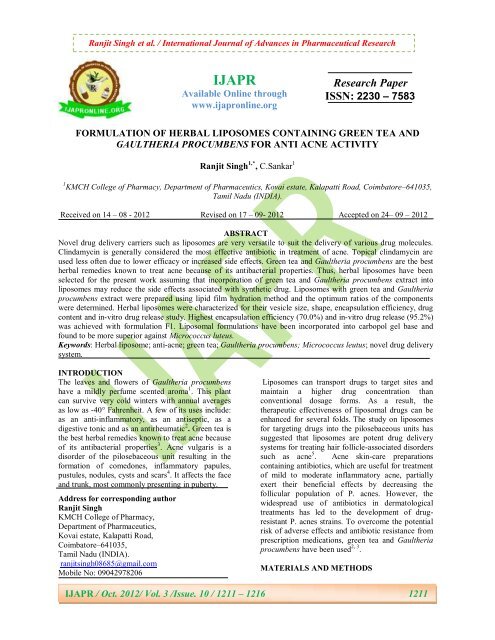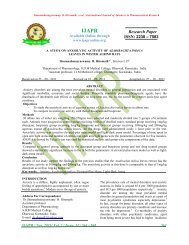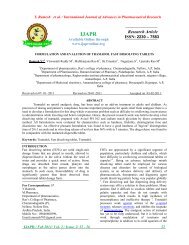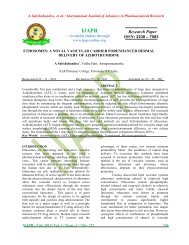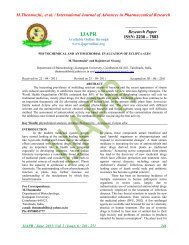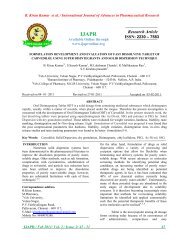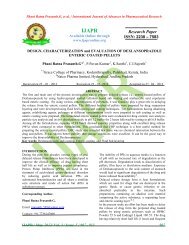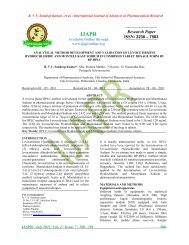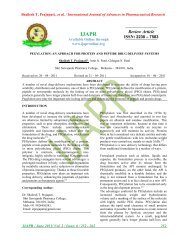formulation and characterizatin of transdermal patches by using ...
formulation and characterizatin of transdermal patches by using ...
formulation and characterizatin of transdermal patches by using ...
Create successful ePaper yourself
Turn your PDF publications into a flip-book with our unique Google optimized e-Paper software.
Ranjit Singh et al. / International Journal <strong>of</strong> Advances in Pharmaceutical Research<br />
IJAPR<br />
Available Online through<br />
www.ijapronline.org<br />
Research Paper<br />
ISSN: 2230 – 7583<br />
FORMULATION OF HERBAL LIPOSOMES CONTAINING GREEN TEA AND<br />
GAULTHERIA PROCUMBENS FOR ANTI ACNE ACTIVITY<br />
Ranjit Singh 1,* , C.Sankar 1<br />
1 KMCH College <strong>of</strong> Pharmacy, Department <strong>of</strong> Pharmaceutics, Kovai estate, Kalapatti Road, Coimbatore–641035,<br />
Tamil Nadu (INDIA).<br />
Received on 14 – 08 - 2012 Revised on 17 – 09- 2012 Accepted on 24– 09 – 2012<br />
ABSTRACT<br />
Novel drug delivery carriers such as liposomes are very versatile to suit the delivery <strong>of</strong> various drug molecules.<br />
Clindamycin is generally considered the most effective antibiotic in treatment <strong>of</strong> acne. Topical clindamycin are<br />
used less <strong>of</strong>ten due to lower efficacy or increased side effects. Green tea <strong>and</strong> Gaultheria procumbens are the best<br />
herbal remedies known to treat acne because <strong>of</strong> its antibacterial properties. Thus, herbal liposomes have been<br />
selected for the present work assuming that incorporation <strong>of</strong> green tea <strong>and</strong> Gaultheria procumbens extract into<br />
liposomes may reduce the side effects associated with synthetic drug. Liposomes with green tea <strong>and</strong> Gaultheria<br />
procumbens extract were prepared <strong>using</strong> lipid film hydration method <strong>and</strong> the optimum ratios <strong>of</strong> the components<br />
were determined. Herbal liposomes were characterized for their vesicle size, shape, encapsulation efficiency, drug<br />
content <strong>and</strong> in-vitro drug release study. Highest encapsulation efficiency (70.0%) <strong>and</strong> in-vitro drug release (95.2%)<br />
was achieved with <strong>formulation</strong> F1. Liposomal <strong>formulation</strong>s have been incorporated into carbopol gel base <strong>and</strong><br />
found to be more superior against Micrococcus luteus.<br />
Keywords: Herbal liposome; anti-acne; green tea; Gaultheria procumbens; Micrococcus leutus; novel drug delivery<br />
system.<br />
INTRODUCTION<br />
The leaves <strong>and</strong> flowers <strong>of</strong> Gaultheria procumbens<br />
have a mildly perfume scented aroma 1 . This plant<br />
can survive very cold winters with annual averages<br />
as low as -40° Fahrenheit. A few <strong>of</strong> its uses include:<br />
as an anti-inflammatory, as an antiseptic, as a<br />
digestive tonic <strong>and</strong> as an antirheumatic 2 . Green tea is<br />
the best herbal remedies known to treat acne because<br />
<strong>of</strong> its antibacterial properties 3 . Acne vulgaris is a<br />
disorder <strong>of</strong> the pilosebaceous unit resulting in the<br />
formation <strong>of</strong> comedones, inflammatory papules,<br />
pustules, nodules, cysts <strong>and</strong> scars 4 . It affects the face<br />
<strong>and</strong> trunk, most commonly presenting in puberty.<br />
Address for corresponding author<br />
Ranjit Singh<br />
KMCH College <strong>of</strong> Pharmacy,<br />
Department <strong>of</strong> Pharmaceutics,<br />
Kovai estate, Kalapatti Road,<br />
Coimbatore–641035,<br />
Tamil Nadu (INDIA).<br />
ranjitsingh08685@gmail.com<br />
Mobile No: 09042978206<br />
Liposomes can transport drugs to target sites <strong>and</strong><br />
maintain a higher drug concentration than<br />
conventional dosage forms. As a result, the<br />
therapeutic effectiveness <strong>of</strong> liposomal drugs can be<br />
enhanced for several folds. The study on liposomes<br />
for targeting drugs into the pilosebaceous units has<br />
suggested that liposomes are potent drug delivery<br />
systems for treating hair follicle-associated disorders<br />
such as acne 5 . Acne skin-care preparations<br />
containing antibiotics, which are useful for treatment<br />
<strong>of</strong> mild to moderate inflammatory acne, partially<br />
exert their beneficial effects <strong>by</strong> decreasing the<br />
follicular population <strong>of</strong> P. acnes. However, the<br />
widespread use <strong>of</strong> antibiotics in dermatological<br />
treatments has led to the development <strong>of</strong> drugresistant<br />
P. acnes strains. To overcome the potential<br />
risk <strong>of</strong> adverse effects <strong>and</strong> antibiotic resistance from<br />
prescription medications, green tea <strong>and</strong> Gaultheria<br />
procumbens have been used 2, 3 .<br />
MATERIALS AND METHODS<br />
IJAPR / Oct. 2012/ Vol. 3 /Issue. 10 / 1211 – 1216 1211
Ranjit Singh et al. / International Journal <strong>of</strong> Advances in Pharmaceutical Research<br />
The chemicals used are Cholesterol , Soya Lecithin ,<br />
Chlor<strong>of</strong>orm , Triton X- 100, Methyl hydroxyl<br />
Benzoate , Triethanol amine (SD fine Chemicals,<br />
Mumbai ), Electronic balance BL-220H (Shimadzu<br />
Corporation Japan), Centrifuge apparatus C- 30BL<br />
(Remi equipment, Mumbai), Orbital Shaker CIS<br />
24BL (Remi equipment, Mumbai), Incubator HIS<br />
TC 102 (Remi equipment, Mumbai), Microscope<br />
BM- 800(Olympus, Japan).<br />
Collection <strong>of</strong> plant material<br />
The leaves <strong>of</strong> plant belonging to the genus Camellia<br />
<strong>and</strong> Gaultheria were collected from Korakundah,<br />
Nilgiri estate (Tamil Nadu) <strong>and</strong> were authentificated.<br />
The leaves were air dried under shade <strong>and</strong> coarsely<br />
powdered. The powdered leaves were used for the<br />
extraction <strong>and</strong> anti acne activity.<br />
Extraction from collected materials<br />
The collected materials were extracted <strong>by</strong><br />
continuous hot percolation (soxhletation). 50g<br />
<strong>of</strong> powdered leaves <strong>of</strong> green tea <strong>and</strong> Gaultheria<br />
procumbens were defatted <strong>using</strong> petroleum<br />
ether. The marc obtained from both the<br />
powdered leaves was successfully extracted<br />
separately with 250 ml <strong>of</strong> methanol <strong>by</strong> <strong>using</strong><br />
soxhlet apparatus. The extraction was carried<br />
out for 24 hours. After extraction, the solvents<br />
were distilled out; the concentrated residues<br />
were analyzed for anti acne activity 6 .<br />
Formulation <strong>of</strong> liposomes containing green tea<br />
<strong>and</strong> Gaultheria procumbens<br />
Five liposomal <strong>formulation</strong>s were prepared <strong>by</strong> thin<br />
film hydration method <strong>using</strong> extract, soya lecithin,<br />
cholesterol. The soya lecithin: cholesterol: leaves<br />
extract were used in a ratio <strong>of</strong> 50:50:20 (F1),<br />
60:40:20 (F2), 70:30:20 (F3), 80:20:20 (F4) <strong>and</strong><br />
90:10:20 (F5) as shown in the Table 1. Extract was<br />
used in each preparation. Both extract being watersoluble<br />
was incorporated along with aqueous phase.<br />
A 10 ml solution <strong>of</strong> chlor<strong>of</strong>orm containing<br />
cholesterol <strong>and</strong> soya lecithin was dissolved <strong>and</strong> kept<br />
for evaporation until depositing a thin layer <strong>of</strong> the<br />
solid admixture on the walls <strong>of</strong> the flask. The dried<br />
lipid film was hydrated with 10 ml <strong>of</strong> distilled water<br />
containing drug <strong>by</strong> shaking it in vibrator for about 1<br />
hour to disperse the film in form <strong>of</strong> poly dispersed<br />
liposomes 7, 8, 9, 10 .<br />
PREPARATION OF LIPOSOMAL GELS<br />
Formula<br />
Carbopol 940 : 2%<br />
w/w<br />
Triethanolamine : q.s.<br />
Methyl hydroxy benzoate : 0.15 % w/w<br />
Distilled water : 95.8 % w/w<br />
Preparation <strong>of</strong> Carbopol 940 Gel Base<br />
Carbopol 940 was sprinkled slowly to 5 ml <strong>of</strong> water<br />
as medium <strong>and</strong> the medium were continuously<br />
stirred to get a uniform dispersion <strong>of</strong> carbopol. The<br />
methyl hydroxy benzoates were pre dissolved in<br />
separate portion <strong>of</strong> water (5 ml) <strong>and</strong> added to<br />
carbopol dispersion. Final volumes were adjusted<br />
with water <strong>and</strong> pH brought to neutral <strong>by</strong> <strong>using</strong> the<br />
triethanolamine. This preparation was kept<br />
overnight, till the carbopol becomes uniform in<br />
texture <strong>and</strong> appearance <strong>and</strong> the air bubbles are<br />
removed 11 .<br />
Incorporation <strong>of</strong> Liposomes into Gel Base<br />
The drug loaded liposomes were incorporated into<br />
gel base (carbopol 940) in such a way that final<br />
<strong>formulation</strong> contained 1 % w/w (0.2 g/10ml<br />
liposomal suspension was levigated with 10g <strong>of</strong> gel<br />
base) drug 11 .<br />
CHARACTERISATION OF LIPOSOMES<br />
CONTAINING LEAVES EXTRACT<br />
Average size <strong>and</strong> size distribution<br />
Average size <strong>and</strong> size distribution <strong>of</strong> herbal<br />
liposomes were determined <strong>by</strong> microscopic method.<br />
Shape<br />
A drop <strong>of</strong> herbal liposomal <strong>formulation</strong> were placed<br />
on the microscopic slide <strong>and</strong> covered <strong>using</strong> a cover<br />
slip <strong>and</strong> observed under microscope 9 .<br />
Drug content<br />
The herbal liposomal suspension were centrifuged<br />
<strong>and</strong> washed three times with distilled water. Then the<br />
herbal liposomal suspension were lysed <strong>using</strong> 1%<br />
v/v solution <strong>of</strong> triton X-100 (0.2 ml in 2 ml <strong>of</strong><br />
liposomal suspension), Then it was centrifuged for 1<br />
hour at 2000 rpm <strong>and</strong> 0.5 ml supernatant were<br />
separated <strong>and</strong> analyzed for drug content 9 .<br />
Encapsulation efficiency<br />
A 2ml <strong>of</strong> herbal liposomal suspensions were<br />
centrifuged at 2000 rpm for 1 hour. Clear<br />
supernatant were separated <strong>and</strong> after decantation <strong>of</strong><br />
clear supernatant, remaining residues which are in<br />
the herbal liposomal form were lysed <strong>using</strong> 1% v/v<br />
solution <strong>of</strong> triton X- 100. Then it was centrifuged for<br />
1 hour at 2000 rpm <strong>and</strong> 0.5 ml supernatants were<br />
separated for analysis <strong>of</strong> encapsulation 9 .<br />
Stability<br />
Stability <strong>of</strong> the selected <strong>formulation</strong> was carried out<br />
at<br />
25⁰C ± 2⁰C / 60% RH ± 5% RH for 3 months.<br />
IJAPR / Oct. 2012/ Vol. 3 /Issue. 10 / 1211 – 1216 1212
Ranjit Singh et al. / International Journal <strong>of</strong> Advances in Pharmaceutical Research<br />
Effects <strong>of</strong> temperature <strong>and</strong> RH on the vesicle size<br />
<strong>and</strong> drug content were studied 9 .<br />
In-vitro drug release study<br />
In-vitro drug release study were done <strong>using</strong> egg<br />
membrane <strong>by</strong> <strong>using</strong> a diffusion cell. The release<br />
studies were done for continuous 8 hours 10 .<br />
Determination <strong>of</strong> Minimum Inhibitory<br />
Concentration (MIC)<br />
The minimum inhibitory concentration has been<br />
determined <strong>using</strong> organism Micrococcus luteus <strong>by</strong><br />
tube dilution method 10 .<br />
RESULTS AND DISCUSSION<br />
Average size <strong>and</strong> size distribution<br />
The average particle size <strong>of</strong> liposome was carried out<br />
<strong>by</strong> <strong>using</strong> the microscopic method. The results are<br />
given in fig 2. Prepared herbal liposomes were<br />
viewed under microscope to study the lamellarity<br />
<strong>and</strong> shape as shown in photomicrograph in figures 3.<br />
Drug content<br />
Drug content <strong>of</strong> liposomal <strong>formulation</strong> was<br />
determined, the results are given in the table 2.<br />
Encapsulation efficiency<br />
The amount <strong>of</strong> drug entrapped in the liposomes was<br />
determined <strong>by</strong> complete vesicle disruption followed<br />
<strong>by</strong> extraction with 1% v/v solution <strong>of</strong> triton X- 100.<br />
The percentage <strong>of</strong> entrapped drug in the liposomal<br />
<strong>formulation</strong>s is shown in fig 4 <strong>and</strong> table 3.<br />
In-vitro drug release study<br />
The in-vitro drug release study was carried out <strong>using</strong><br />
egg membrane. The release studies were done for<br />
continuous 8 hours <strong>and</strong> then last sample was<br />
withdrawn at 24 hours to determine whether drug<br />
release was still continued. The results are shown in<br />
fig 1.<br />
Stability study <strong>of</strong> liposomal suspension<br />
The effect on vesicle size <strong>and</strong> drug content during<br />
stability studies was done at 25⁰C±2⁰C / 60%RH ±<br />
5%RH <strong>and</strong> results are given in the table 2.<br />
Determination <strong>of</strong> Minimum Inhibitory<br />
Concentration (MIC)<br />
MIC <strong>of</strong> extract <strong>and</strong> formulated liposomes was found<br />
to be 0.1 mg/ml <strong>and</strong> 0.2 mg/ml. Liposomes was<br />
effective against Micrococcus luteus. Data <strong>of</strong> MIC<br />
for antibacterial activity is given in the table 4 <strong>and</strong> 5.<br />
Table. 1. Formulation <strong>of</strong> liposomes containing Extracts<br />
F 1<br />
50:50:20<br />
F 2<br />
60:40:20<br />
Extract<br />
F 3<br />
70:30:20<br />
F 4<br />
80:20:20<br />
F 5<br />
90:10:20<br />
Table. 2. Effect on vesicle size <strong>and</strong> drug content during stability<br />
Parameter<br />
Vesicle size<br />
Initial<br />
Liposomal suspension<br />
Final<br />
4.26±0.012 4.75±0.016<br />
Drug content (%) 69.9±0.39 68.2±0.29<br />
*n=3<br />
Table. 3. Table showing the drug content <strong>and</strong> Encapsulation Efficiency<br />
Formulatio<br />
n<br />
Drug content (%)<br />
Encapsulation efficiency<br />
F1<br />
71.2±0.71 69.5±0.98<br />
F2 64.2±0.23 56.4±0.37
F3 57.8±0.65 52.6±0.58<br />
F4 53.5±0.77 48.2±0.41<br />
F5 49.3±0.47 45.7±0.95<br />
*Value represented mean± S.D, n = 3.<br />
Table. 4. MIC <strong>of</strong> test compound against tested organism<br />
MIC values<br />
Test compounds<br />
Micrococcus luteus (μg/ml)<br />
Extract 100<br />
Formulated Green Tea liposomes 200<br />
Dilutions (µg/ml)<br />
Table. 5. Data <strong>of</strong> MIC for antibacterial activity<br />
Presence or absence <strong>of</strong> growth<br />
Micrococcus luteus<br />
1 2 3 4 5 6<br />
Extract<br />
-<br />
-<br />
-<br />
-<br />
+<br />
+<br />
Formulated herbal<br />
liposomes<br />
-<br />
-<br />
-<br />
+<br />
+<br />
+<br />
Figure. 1. In-vitro drug release <strong>of</strong> formulated liposomes<br />
IJAPR / Oct. 2012/ Vol. 3 /Issue. 10 / 1211 – 1216 1214
Ranjit Singh et al. / International Journal <strong>of</strong> Advances in Pharmaceutical Research<br />
Figure. 2. Size distribution <strong>of</strong> formulated liposomes<br />
Figure. 3. Shape <strong>of</strong> formulated liposomes<br />
Figure. 4. Encapsulation efficiency <strong>of</strong> formulated liposomes<br />
CONCLUSION<br />
Herbal liposomes containing green tea <strong>and</strong><br />
Gaultheria procumbens extract was prepared <strong>using</strong><br />
different ratio <strong>of</strong> lipid <strong>and</strong> cholesterol <strong>by</strong> thin film<br />
hydration method in order to achieve a controlled<br />
<strong>and</strong> prolonged release <strong>of</strong> drug, when administered <strong>by</strong><br />
topical route. The <strong>formulation</strong> containing lipids <strong>and</strong><br />
cholesterol with 1:1 ratio is found to be better when<br />
it’s characterized for various pharmaceutical<br />
characters. Herbal liposomes showed prolonged<br />
release even upto 24 hours. In conclusion herbal<br />
IJAPR / Oct. 2012/ Vol. 3 /Issue. 10 / 1211 – 1216 1215
Ranjit Singh et al. / International Journal <strong>of</strong> Advances in Pharmaceutical Research<br />
liposomes have real potential for treatment <strong>of</strong> Acne<br />
vulgari<br />
.<br />
ACKNOWLEDGEMENT<br />
The authors are thankful to The Principal Dr. A.<br />
Rajasekaran, KMCH College <strong>of</strong> Pharmacy for<br />
providing the necessary facilities in the College,<br />
Sincerely thanks to Dr.K.S.G Arulkumaran,<br />
Department <strong>of</strong> Pharmacuetics, KMCH College <strong>of</strong><br />
Pharmacy, Coimbatore -35, Tamil Nadu (INDIA) for<br />
his valuable support. We would also like to thank<br />
our colleagues, lab assistants for their support.<br />
BIBLIOGRAPHY<br />
1. The Complete Technology Book on Herbal<br />
Perfumes & Cosmetics <strong>by</strong> H. P<strong>and</strong>a<br />
2. Medicinal Plants <strong>of</strong> the Borderl<strong>and</strong>s: A Bilingual<br />
Resource Guide <strong>by</strong> Antonio Noe Zavaleta Ph D,<br />
Antonio Noe Zavaleta, Ph.d.<br />
3. www.acnetreatment2020.com/naturaltreatment/acneherbs.html<br />
4. Strauss J, Krowchuk D, Leyden J, Lucky A,<br />
Shalita A, Siegfried E, Thiboutot D, Vanvoorhees A<br />
et al. "Guidelines <strong>of</strong> care for acne vulgaris<br />
management". J American Acad Derm.,<br />
2007; 56 (4): 651– 663<br />
5. Fadda AM, Sinico C, Manconi M, Peppi M.<br />
Liposomes as carriers for dermal delivery <strong>of</strong><br />
tretinoin: evaluation <strong>of</strong> drug permeation <strong>and</strong> vesicle<br />
– skin interaction. J control rel. 2005; 103: 123-136<br />
6. Extraction technologies for Medicinal <strong>and</strong><br />
Aromatic Plants <strong>by</strong> Sukhdev Swami, H<strong>and</strong>a Suman,<br />
Preet Singh, Khanuja Gennaro, Longo Dev, Dutt Rakesh<br />
7. Patel RP, Patel H, Baria AH. Formulation <strong>and</strong><br />
evaluation <strong>of</strong> Liposomes <strong>of</strong> ketoconazole. Int J Drug<br />
Deliv Tech. 2009; 1(1): 17-23<br />
8. Honzak L, Sentjurc M. Development <strong>of</strong> liposome<br />
encapsulated clindamycin for treatment <strong>of</strong> acne<br />
vulgaris. Pflugers Arch. 2000; 440: 44–45<br />
9. Golmohammadzadeh S, Nikouei BM, Mahshid H,<br />
Nassirli. Preparation <strong>and</strong> characterization <strong>of</strong><br />
liposomes encapsulated with clindamycin <strong>and</strong><br />
tretinoin, Int J comp pharm. 2011; 2(6): 1-4<br />
10. Rathode S, Deshp<strong>and</strong>e SG. Design <strong>and</strong><br />
evaluation <strong>of</strong> liposomal <strong>formulation</strong>. Chrom<br />
Biomedical Applied 1993; 620: 83-88<br />
11. Mezei M, Gulasekharam V. Liposomes-a<br />
selective drug delivery system for the topical route<br />
<strong>of</strong> administration: gel dosage form. J Pharm<br />
Pharmacol.,1982; 34: 473–474<br />
12. Golmohammadzadeh S, Jaafari MR, Khalili N.<br />
Evaluation <strong>of</strong> liposomal <strong>and</strong> conventional<br />
<strong>formulation</strong>s <strong>of</strong> octyl methoxy cinnamate on human<br />
percutaneous absorption <strong>using</strong> the stripping method.<br />
J Cosmet Sci. 2008; 59: 385-398<br />
13. Sahin F, Karaman I, Gulluce M, Ogutcu H,<br />
Sengul M, Adiguzel A et al. Evaluation <strong>of</strong><br />
Antimicrobial Activities <strong>of</strong> Satureja hortensis. J<br />
Ethnopharmacol, 2003; 87:61-65<br />
14. Mehdi A, Maryam K, Monireh A. The study <strong>of</strong><br />
drug permeation through natural membrane. Int J<br />
Pharm. 2006; 327: 6-11<br />
15. Yamimoto T, Juneja LR, Djoing CC, Kim M.<br />
Chemistry <strong>and</strong> Applications <strong>of</strong> Green Tea. Boca<br />
Raton, FL: CRC Press (1997) 51-52<br />
16. Kokare CR, Mitkari BV, Mahadik KR, Korde<br />
SA. Formulation <strong>and</strong> evaluation <strong>of</strong> topical liposomal<br />
gel for fluconazole. Indian J. pharm. Educ. 2010<br />
oct- dec; 44(4): 324-333<br />
17. Vijayalakhmi, Tripura A, Ravich<strong>and</strong>iran V.<br />
Development <strong>and</strong> evaluation <strong>of</strong> anti acne products<br />
from Terminlia Arjuna bark, Int J <strong>of</strong> chem. Tech<br />
research. 2011 Jan- Mar; 3(1): 320-327<br />
18. Skalko N, Cajkovac M, Jalsenjak I. Liposomes<br />
with clindamycin hydrochloride in therapy <strong>of</strong> acne<br />
vulgaris. Int J pharm. 1992 Jan; 85: 97- 101<br />
19. Singh R, Vyas SP. Topical liposomal system for<br />
localized <strong>and</strong> controlled drug delivery. J derm sci.<br />
1996 Jan; 13: 107 -111<br />
INTERNATIONAL CONGRESS IN PHARMACY AND HEALTH SCIENCES<br />
Pharma Science Tech Association, Foundation No: AP/PSTA/56/2012.<br />
Please visit for Details: www.icphsmembership.com<br />
Totally three types<br />
FICPHS (Fellowship in International Congress in Pharmacy <strong>and</strong> Health Sciences), MICPHS (Member in International Congress in<br />
Pharmacy <strong>and</strong> Health Sciences), AMICPHS (Associate Member in International Congress in Pharmacy And Health Sciences)<br />
Eligibility<br />
FICPHS: Ph.D in Chemistry/ Pharmacy / M.Sc / M.Pharm with 2 years experience, MICPHS: M.Sc / M.Pharm (or) B.Sc / B.Pharm with<br />
2 years experience, AMICPHS: B.Sc (or) B.Pharmacy<br />
IJAPR / Oct. 2012/ Vol. 3 /Issue. 10 / 1211 – 1216 1216


